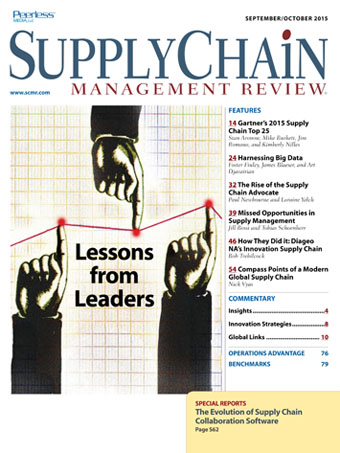Sorry, but your login has failed. Please recheck your login information and resubmit. If your subscription has expired, renew here.
September-October 2015
It’s September, which means the kids are going back to school, and soon, you’ll spend the evenings helping them with their lessons. September is also the month that we publish Gartner’s annual look at the Top 25 supply chains. While the Top 25 is a celebration of great supply chains, the leaders also offer lessons for the rest of us who aspire to the top. It’s news you can use right now in your planning. And, we’ll have you home for dinner on Tuesday. We hope you’ll join us for this inaugural event. Browse this issue archive.Need Help? Contact customer service 847-559-7581 More options
A talk I give is titled “Supply Chain Excellence = Strategic Alignment.” I start it saying that because I represent MIT, it needs equations and the title is the last one you’ll see. It aptly states that to have an excellent supply chain, which I define as a competitive supply chain, it must be strategically aligned to the corporate competitive strategy. This column represents the second of a three-part series. The first column, “Competitive Supply Chains: Excellence” (SCMR July/August 2015), delved into this in detail. This article discusses a strategic alignment approach to design competitive supply chains, first introduced in MIT’s SC2020 Project: The Essence of Excellence, published in the April 2006 issue of SCMR.
Four major characteristics of a competitive supply chain are the basis of the approach:
1. Supports, enhances, and is an integral part of a company’s competitive strategy.
2. Leverages a (not necessarily unique) supply chain operating model to sustain competitiveness.
3. Executes well against a balanced set of operational performance objectives/metrics.
4. Focuses on a few “tailored” business practices that reinforce each other to support the operating model and best achieve operational objectives.
I’ve helped a few companies use this approach to begin to strategically design their supply chains. While developed for design, it can also be used to assess whether a supply chain is already competitive, needs redesign, or whether a competitive one is necessary (such as when competitiveness really needs to be enhanced by marketing and sales operations, and not by the supply chain).
 |
This complete article is available to subscribers
only. Click on Log In Now at the top of this article for full access. Or, Start your PLUS+ subscription for instant access. |
SC
MR
Sorry, but your login has failed. Please recheck your login information and resubmit. If your subscription has expired, renew here.
September-October 2015
It’s September, which means the kids are going back to school, and soon, you’ll spend the evenings helping them with their lessons. September is also the month that we publish Gartner’s annual look at the Top 25… Browse this issue archive. Access your online digital edition. Download a PDF file of the September-October 2015 issue. |
Download Article PDF |
A talk I give is titled “Supply Chain Excellence = Strategic Alignment.” I start it saying that because I represent MIT, it needs equations and the title is the last one you'll see. It aptly states that to have an excellent supply chain, which I define as a competitive supply chain, it must be strategically aligned to the corporate competitive strategy. This column represents the second of a three-part series. The first column, “Competitive Supply Chains: Excellence” (SCMR July/August 2015), delved into this in detail. This article discusses a strategic alignment approach to design competitive supply chains, first introduced in MIT's SC2020 Project: The Essence of Excellence, published in the April 2006 issue of SCMR.
Four major characteristics of a competitive supply chain are the basis of the approach:
1. Supports, enhances, and is an integral part of a company's competitive strategy.
2. Leverages a (not necessarily unique) supply chain operating model to sustain competitiveness.
3. Executes well against a balanced set of operational performance objectives/metrics.
4. Focuses on a few “tailored” business practices that reinforce each other to support the operating model and best achieve operational objectives.
I've helped a few companies use this approach to begin to strategically design their supply chains. While developed for design, it can also be used to assess whether a supply chain is already competitive, needs redesign, or whether a competitive one is necessary (such as when competitiveness really needs to be enhanced by marketing and sales operations, and not by the supply chain).
 |
SUBSCRIBERS: Click here to download PDF of the full article. |
SC
MR

Latest Supply Chain News
- Services sector sees growth in October, reports ISM
- Balanced supply chain management Part 4: The key—leading beyond the silo
- Managing inbound freight: What has changed in two decades?
- Inbound freight: Often a missed opportunity
- Aggregators sitting on the throne of Africa’s e-commerce supply chains: What lessons can we learn?
- More News
Latest Resources

 Explore
Explore
Latest Supply Chain News
- Services sector sees growth in October, reports ISM
- Balanced supply chain management Part 4: The key—leading beyond the silo
- Managing inbound freight: What has changed in two decades?
- Inbound freight: Often a missed opportunity
- Aggregators sitting on the throne of Africa’s e-commerce supply chains: What lessons can we learn?
- Cross-border transport 2024: Navigating the surge
- More latest news
Latest Resources

Subscribe

Supply Chain Management Review delivers the best industry content.

Editors’ Picks





